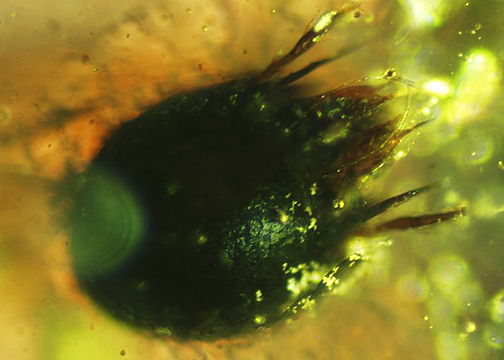Abstract
Burmese amber originates from the Hukawng Valley in northern Myanmar (Burma). Shi et al. (2012) proposed an age of ca. 99 Ma based on zircon dating, whereas Smith & Ross (2018) proposed an age of 100 Ma based on sediments inside amber produced by bored bivalves. Regarding the plant producing resin Cruickshank & Ko (2003) recorded spores both of Araucariaceae and Taxodiaceae origin. Poinar et al. (2007) proposed an araucariacean origin due to the similitudes with modern kauri pines (Agathis) from New Zealand, while Grimaldi & Ross (2017) suggested the possibility of a Cupressaceae (Metasequoia) origin. Although amber inclusions from Myanmar were first described by Cockerell (1916), great interest (and a huge number of papers) in this biota started only two decades ago.
References
- Cockerell, T.D.A. (1916) Insects in Burmese amber. American Journal of Science, (4) 42, 135–138. https://doi.org/10.2475/ajs.s4-42.248.135
- Corral, J.C., López del Valle, R. & Alonso, J. (1999) El ámbar cretácico de Álava (Cuenca Vasco-Cantábrica, norte de España). Su colecta y preparación. Estudios del Museo de Ciencias Naturales de Álava, 14 (nº especial 2), 7–21.
- Cruickshank, R.D. & Ko, K. (2003) Geology of an amber locality in the Hukawng Valley, northern Myanmar. Journal of Asian Earth Sciences, 21, 441–455. https://doi.org/10.1016/S1367-9120(02)00044-5
- Grimaldi, D.A. & Ross, A.J. (2017) Extraordinary Lagerstätten in amber, with particular reference to the Cretaceous of Burma. In: Fraser, N.C. & Sues, H.-D. (Eds), Terrestrial Conservation Lagerstätten: Windows into the Evolution of Life on Land. Dunedin Academic Press Ltd, Edinburgh, 287–342.
- Krivolutsky, D.A. & Krassilov, B.A. (1977) Oribatid mites from Upper Jura deposits of USSR. In: Skarlato, O.A. & Balashov, Y.S. (Eds), Morphology and diagnostics of mites. Zoological Institute, Leningrad, pp. 16–24.
- Nascimbene, P. & Silverstein, H. (2000) The preparation of fragile Cretaceous ambers for conservation and study of organismal inclusions. In: Grimaldi, D. (Ed.), Studies on fossils in amber, with particular reference to the Cretaceous of New Jersey. Backhuys, Leiden, Netherlands, pp. 93–102.
- Norton, R.A., Bonamo, P.M., Grierson, J.D. & Shear, W.A. (1988) Oribatid mite fossils from a terrestrial Devonian deposit near Gilboa, New York. Journal of Paleontology, 62, 259–269. https://doi.org/10.1017/S0022336000029905
- Poinar, G.O., Jr., Lambert, J.B. & Wu, Y. (2007) Araucarian source of fossiliferous Burmese amber: Spectroscopic and anatomical evidence. Journal of the Botanical Research Institute of Texas, 1 (1), 449–455
- Rasnitsyn, A.P., Bashkuev, A.S., Kopylov, D.S., Lukashevich, E.D., Ponomarenko, A.G., Popov, Y.A., Rasnitsyn, D.A., Ryzhkova, O.V., Sidorchuk, E.A., Sukatsheva, I.D. & Vorontsov, D.D. (2016) Sequence and scale of changes in the terrestrial biota during the Cretaceous (based on materials from fossil resins). Cretaceous Research, 61, 234–255. https://doi.org/10.1016/j.cretres.2015.12.025
- Schatz, H. & Behan-Pelletier, V. (2008) Global diversity of oribatids (Oribatida: Acari: Arachnida). Hydrobiologia, 595, 323–328. https://doi.org/10.1007/s10750-007-9027-z
- Shi, G.H., Grimaldi, D.A., Harlow, G.E., Wang, J., Wang, J. & Yang, M.C. (2012) Age constraint on Burmese amber based on U-Pb dating of zircons. Cretaceous Research, 37, 155–163. https://doi.org/10.1016/j.cretres.2012.03.005
- Smith, R.D.A. & Ross, A. (2018) Amberground pholadid bivalve borings and inclusions in Burmese amber: implications for proximity of resin-producing forests to brackish waters, and the age of the amber. Earth and Environmental Science Transactions of the Royal Society of Edinburgh, 107 (2–3), 1–9. https://doi.org/10.1017/S1755691017000287
- Subías, L.S. (2004) Listado sistemático, sinonímico y biogeográfico de los ácaros oribátidos (Acariformes, Oribatida) del mundo (1758–2002). Graellsia, 60, 3–305. (17th update 2022). https://doi.org/10.3989/graellsia.2004.v60.iExtra.218
- Subías, L.S. & Arillo, A. (2002) Oribatid fossil mites from the Upper Devonian of South Mountain, New York and the Lower Carboniferous of County Antrim, North Ireland (Acariformes, Oribatida). Estudios del Museo de Ciencias Naturales de Álava, 17, 93–106.


